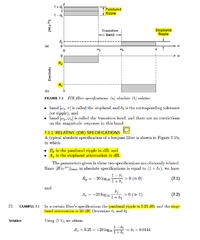robismyname
Full Member level 6

- Joined
- Jan 17, 2008
- Messages
- 390
- Helped
- 11
- Reputation
- 22
- Reaction score
- 9
- Trophy points
- 1,298
- Location
- Central Florida
- Activity points
- 4,603
General math concepts slips my mind for solving for a variable called "δ1" in the following example (Example 7.1-below)
EXAMPLE 7.1
In a certain filter’s specifications the passband ripple is 0.25 dB, and the stopband
attenuation is 50 dB. Determine δ1.
Answer says:
Using ( formula 7.1)
Rp = −20 log10 * [(1 − δ1)/(1 + δ1)]> 0 (≈ 0) [Formula 7.1]
we obtain
Rp = 0.25 = −20 log10*[(1 − δ1)/(1 + δ1)]⇒ δ1 = 0.0144
The author left out a few steps that i cannot seem to remember to execute from previous algebra experience. Does any one care to relieve me of some of my ignorance? Specifically how do you solve for "δ1" when its located in te num and den?
I attached the full page from the book for added convenience.

EXAMPLE 7.1
In a certain filter’s specifications the passband ripple is 0.25 dB, and the stopband
attenuation is 50 dB. Determine δ1.
Answer says:
Using ( formula 7.1)
Rp = −20 log10 * [(1 − δ1)/(1 + δ1)]> 0 (≈ 0) [Formula 7.1]
we obtain
Rp = 0.25 = −20 log10*[(1 − δ1)/(1 + δ1)]⇒ δ1 = 0.0144
The author left out a few steps that i cannot seem to remember to execute from previous algebra experience. Does any one care to relieve me of some of my ignorance? Specifically how do you solve for "δ1" when its located in te num and den?
I attached the full page from the book for added convenience.


